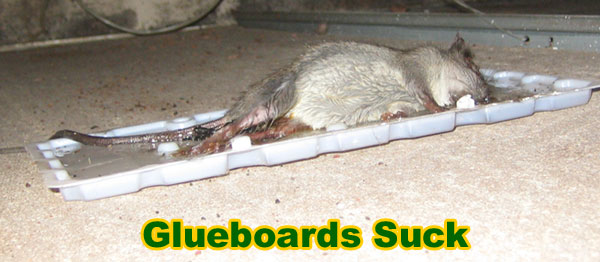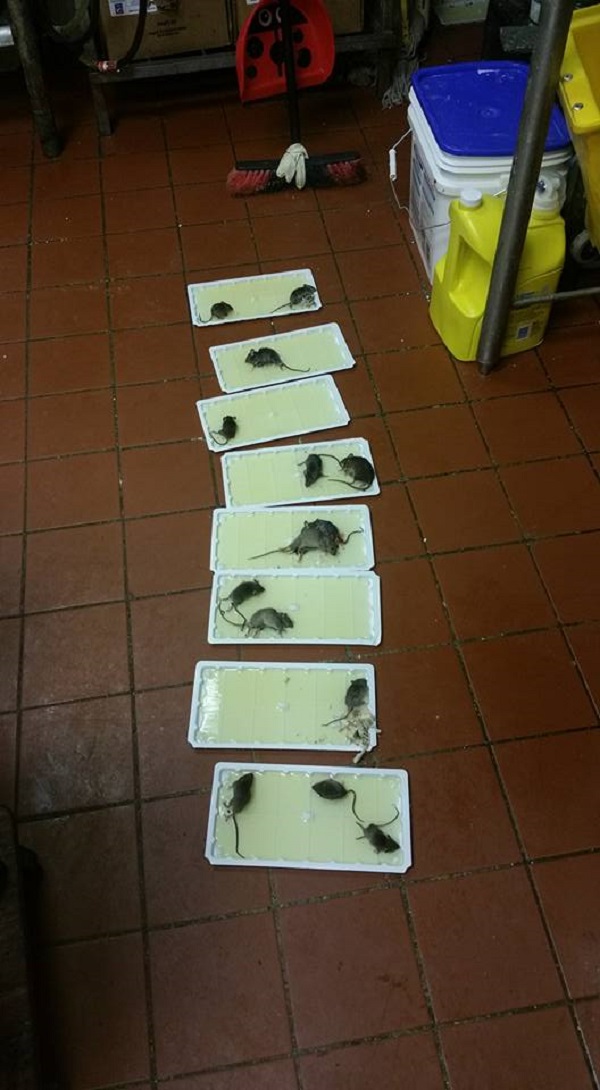There is no reason to use glueboard traps for mice. They don't work very well. They are inhumane. They are one-use products, and thus not economical.

Glue traps are the cruelest techniques of killing mice today; they are also known as glue boards because of the materials used in making them. Glue traps are therefore made using pieces of cardboards, or fiberboards. The sides of the board are then coated with some sticky adhesive to ensnare any animal that comes into direct contact with the trap. In spite of being the most inhumane type of traps that exist in the market today, they are very cheap and sold in most open markets.
How do these traps work?
Adhesive materials like glue, mineral oils and synthetic rubber are usually stuck on the board; the trap is then treated with food flavoring whose main purpose is to lure the mice towards the trap. Once the mice come into contact with the traps, they are immediately snared and immobilized. The glue on the traps will either rip patches of their skin and fur or suffocate them to death if their faces get stuck on the trap. Animals ensnared on these traps usually starve to death hence chances for their survival are usually minimal that is why the wildlife authority categorizes this trap as an inhumane one.
Aftermath of mice trapped
There are different sizes of these traps; if the board is small for instance a bigger mouse can escape by pulling itself off the board but it may either lose its skin or fur but if the mouse is small, it has no means of escaping.
It takes a couple of days for an ensnared mouse to die, some may succumb to death due to exhaustion as they struggle to free themselves, other due to suffocation in case their faces stick on the board while others may die because of starvation. In most cases, the mice die from a combination of starvation, suffocation and dehydration.
It is very inhumane to use glue boards not only to mice but any other animal because:
- They cause a lot of suffering than any other wildlife control product; animals including mice caught on this traps usually suffer slow deaths which are vey agonizing.
- Chances of safely euthanizing animals when caught on these traps are very slim, therefore they end up dying.
- Releasing animals stuck on these traps doesn’t help because chances of their survival are usually low; most of them succumb to death after a while because of massive injuries, intense stress and other effects caused by the glue.
It is very unfortunate that these traps are readily available in open markets, hardware stores and most major retailer outlets which make it very difficult to completely bar humans from using it when trapping mice and other animals.
Go back to the
How To Get Rid of Mice in the Attic home page.
Or you can read more mouse control information, on these topics:
How to kill mice
Does mouse repellent work?
Get mice out of the wall
Mouse poison analysis
Do mice live in urban or wild areas?
Do mice make good pets?
Do mice come through the plumbing?
Are glueboards good to catch mice?
Can you catch a mouse in a cage?
What can mice climb?
It may be set inside the house where someone suspects that there are rodent infestations.
The companies that make glue boards do not say that they can make the mouse die faster. They normally suggest throwing the
board in the trash together with the live animal that is still stuck on its surface. This makes the animal suffer and to
eventually die exhausted after it has starved for at least five days.

You should not use the glue boards if you want to trap mice. They will not work, they are not humane, and since they are used just
once, they are not cheap. The glue trap is the cruelest method that people use to kill mice. They are called glue boards because of
the materials that are used to make them. The glue boards are made using cardboard and fiberboards. One side of the board is coated
with sticky adhesive that can ensnare a mouse when it comes into contact with the sticky material. Although they are inhumane traps,
they are widely used since they are cheap – but the costs add up if you have more than one mouse to catch.
The adhesive materials such as synthetic rubber, mineral oil and glue may be put on the board, and the trap will be baited with food to
attract the mice. When the mouse comes in contact with the glue materials, it will be immobilized. The glue can rip off patches of fur
and skin of the mouse or it can suffocate them until they die when the face touches the glue material. The mice that get stuck on such
traps will die in the end because of starving and there is no chance to survive.
The glue boards are found in many sizes. But when small sized boards are used, bigger mice may escape with them or they may pull themselves away.
It takes around 2 days for the mouse on the trap to die because of exhaustion of trying to free itself. Others may die because of suffocation or
starvation. Sometime the mouse can die from a combination of these three.
The traps are known to be inhumane because they will cause too much suffering to any wildlife animal that they attract, and they die a slow death which
is also agonizing. Most of the mice will be left on their own to die and the chance of surviving is too slim. When the animal gets a chance to be released
from the glue, they will die because of too many injuries and stress with other effects which are the result of glue. The problem is that these traps are
found easily at hardware stores and open markets.
Go back to the
How to get rid of mice in the attic home page. You might also want to read about
how to kill mice and why the use
of snap traps is better than
mouse poison. Read an analysis of the different types of traps and how to use them on the
how to trap mice page.
Learn why
bait is not as important as trap type, placement and location. Also read a full analysis of
mouse repellent to understand why it
never works. If you see droppings and want to identify them, read the
mouse poop page. If you need to hire professional help, read about
how much does mouse removal cost?
or you can read this site to learn how to do it yourself. Feel free to email me about An Analysis of the Inhuman Glue Trap for Mice